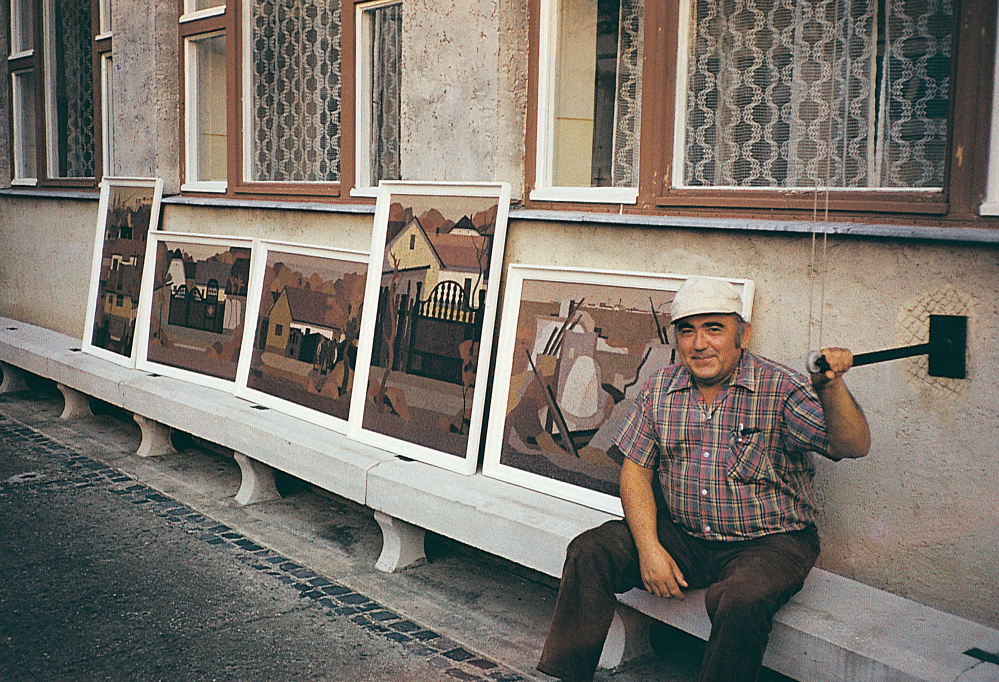In 1964, a summer artist colony of professional and amateur painters was organized for the first time in Hajdúböszörmény. Its leaders were Lajos Bíró and György Zilahy, then Lajos Szlávik. Imre Égerházi was also a founding member of the most significant Hungarian artists’ colony in the era ended by the regime change.
At the Hajdúböszörmény Art Colony
Mid 60s
The position of the colony manager was filled by Ágoston Székelyhidi, between 1968 and 1975, then by Kálmán Csohány, between 1977 and 1979. From 1980, István D. Kurucz became the head of the council of the artists’ colony, and, with Ferenc Hézső and colony manager Imre Lázár, headed the artist camp, which now accepted professional artists only and was declared international in 1971. The merit of the colony maintainers is that they were the first to invite Hungarian artists from across the border. Around 1970, Pál Nagy, Imre Baász, Sándor Plugor (from Transylvania), Béla Bacskai (from Slovakia), Sándor Torok, Hunor Gyurkovics (from Vojvodina) worked here. They were accompanied by Soviet, French, Polish, Norwegian, German and Finnish guest artists. Many of the Hungarian artists visiting here undertook the artistic propagation of Hajdúság and Hortobágy, the landscape of the Hungarian Great Plain, but a branch of those who practiced abstract painting also appeared besides them.
In addition to those mentioned before, Imre Égerházi, Gyula Pál, Balázs Diószegi, János Szurcsik, Piroska Dobi, Ervin Tamás, Imre Bukta, and Anikó Zöld also played an important role in the history of the colony. For a few years, sculptors also worked at the artists ’camp. The doyen of the settlement was Zoltán Maghy (1903 – 1999), who, in addition to Tibor Boromisza and Miklós Káplár, was also a member of the Hortobágy Colony (operating between 1928 and 1930). From 1968, the Hajdúböszörmény International Artist Camp consciously intends to be the successor of the latter. From then on, the Miklós Káplár commemorative medal is awarded annually, which Imre Égerházi received in 1974 and 1982 in recognition of his work. From 1992, István Burai took over the management of the colony.
The opening exhibitions of the summer course were also organized from the works of the previous year’s Káplár Prize winners in the House of Culture, and the Hajdúság Museum. These two institutions preserve artworks donated by the members of the camp. A selection from this collection was included in the exhibition of the Hajdúság Gallery. Besides the season opener, and the closing exhibitions, the works of the colony members were presented outside Hajdúböszörmény throughout the country.
For Imre Égerházi, working at the Hajdúböszörmény Artists’ Colony was of paramount importance, as until his retirement in 1985, he worked at the Insurance Directorate of the Debrecen Society in an 8 to 4 job. That one month in Hajdúböszörmény (which was in August every year) allowed him to concentrate fully on artistic work and development. It was also a good opportunity to exchange ideas, learn and have fun together with domestic and foreign artists. The paintings made at the Hajdúböszörmény camp are outstanding works of art, and by examining them in chronological order we can easily trace the artistic development of Imre Égerházi.
Motifs of County Hajdú
The aim of our colony of artists, formulated some years ago, is to call the participants and creators attention to the material and human world of this part of the country, to this characteristic piece of Hungarian reality.
So civilizing, ethnographic, popular, national characteristics, motives of the land could successfully meet the life-work, will to act of a traditionally sensitive to social phenomena community of artists with realistic view of looking, that had been based on similar ethical and intellectual way of thinking.
Corporate aims, study of present society, natural and material reality, possibility of vivid fixation of feelings and ideas have got supporters of the colony.
The open creative atmospheres of the colony, the participants’ opinion about artistic and aesthetic matters prove the importance and art-political significance of the workroom, too.
The colony considered and considers the lowland painting a value creating and animating tradition, an artistic ambition waiting for renewal, rethinking, further development, enrichment.
The world of County Hajdú and Hortobágy always means some exotism for the natives and foreigners, too. The locust-trees wearied in drying wind, burning radiance of the sun, endlessness of the great puszta, the big life giving cultivated fields, the natives with their particular character have already been the inspirers of art for a long time. Depths, complicated human richness, typical natural endowments of this world are presented in the best works. With the help of the sculptures by Ferenc Medgyessy, the pictures by Miklós Káplár, László Holló and others this land is present in Hungarian culture an stimulates, inspires to creation today, too.
The painters of the workroom in Böszörmény are the depositaries and realizers of an artistic duty, the essence of which is to create a painting, that uses the progressive inheritance of past, painting of the land, while creates an up-to-date, typical, reflecting our vision art, too. Of course this art is determined not by the land, but by that intellectual, artistic position, in which the theme, this human, social milieu, the objective environment created by work and natural surroundings, play a great part. All those, that inspire to the pictorial formulation of experiences, the representation of emotional, intellectual contents.
According to the evidence of the closing exhibitions the pictures horn here speak not about sight-painting. Though the artists start from reality, from its experience, respectively, it forms into a picture according to the laws of art, which guarantee content variety and richness, too. Of course the inner relation, connecting land, man and world, is perceptible in the works well. It gives its inner authenticity. It is a fact that a piece of Hungarian reality, our present awareness of life, humanity, anguish, belief and confidence are transferred – the proper artistic transformation of motives – to the works born of inspired here. Objects and phenomena of reality mean such substantial contents and extent for the creators, that are the bearers of feelings and thoughts actually.
Which are the motives that mostly catch the attention of the artist arriving here, and are suitable for expressing their experiences? These are the workers, the market, the interesting figures of the commotion in the markets, the cyclits, the pub-crawlers, the church-goers, the old people sitting on the benches in the street. Of course not only the world of work is presented in the pictures, but the group of creaters pays attention to the whole existence of social men, too. Feeling of familiarity, serenity, goodness, anguish, fear, anxiety admiration and love are present in the pictures, as well as thought arrangement of pure inditing, demonstration of relations, acceptance of dating associations.
It is true that everything is of importance according to man. Pictorial eyes have discovered wood-work, the beautiful examples of gates, fences in Böszörmény, the ridge of popular Baroque houses, the stepwise built partitionwalls, the roofs, the symbol of human seclusion, the nice graves of cemeteries, the wooden headboards. Particular, single, typical are looked for reasonably in the aspect of the town. They arouse interest. An artist takes his pencil or pen seeing the slender arches of the little churches of Tiszahát, Szamoshát and Hortobágy. Getting acquainted with the unique natural, structural, objective, human world of the endless puszta, its lights, silence, monumentality mean experience. Of course interest is addressed to the Hungarian land a it that has already become a symbol. This land hardly surrenders itself to the artist. But incomparable pictorial possibilities are presented in our sight if its secrets come to light in representation and visualization. Naturally the basic experience is the encounter of the sky and the earth, the open horizon. It is true that the experience of sight gives inspiration to creation, but variety in quality of representation is true, too.
Effort to harmony, lyrical attitude, dramatic effort, suggestive self-expression, energy are present in the pictures. It shows emotional-intellectual richness of the creators and inducing strength of the inspiring concrete land and human common experiences. These are the evidence of deep experience and understanding of our present life, work and the world.
The pictures prove that the motives of the world of County Hajdú and Hortobágy can be the medium of deep thoughts, visions, of an exciting modern painting. Picturesqueness and constructiveness, lightness and strict logical order, emotional saturation and searching for law philosophicalness exit in the paintings of the artists working here. Variety in content and expression reflect this creating of value, too. Experimenting, claim and wish to anew creative endeavours exit here, as well as the activity with traditional but of present view tool. Modern objectiveness of representation, speciality of choice or subject individuality of approaching the theme are characteristic-proving the up-to-dateness of pictorial views.
Hajdúböszörmény, 28th November, 1986
Dr. Imre Lázár






